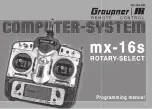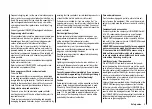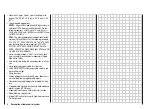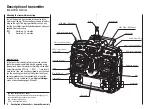
3
We all want you to have many hours of pleasure in our
mutual hobby of modelling, and safety is an important
aspect of this. It is absolutely essential that you read
right through these instructions and take careful note of
all our safety recommendations.
If you are a beginner to the world of radio-controlled mo-
del aircraft, boats and cars, we strongly advise that you
seek out an experienced modeller in your fi eld and ask
him or her for help and advice.
If you ever dispose of this transmitter, these instructions
must be handed on to the new owner.
Application
This radio control system may only be used for the pur-
pose for which the manufacturer intended it, i.e. for ope-
rating radio-controlled models which do not carry hu-
mans. No other type of use is approved or permissible.
Safety notes
SAFETY IS NO ACCIDENT
and …
RADIO-CONTROLLED MODELS ARE NOT
PLAYTHINGS
Even small models can cause serious personal inju-
ry and damage to property if they are handled incompe-
tently.
Technical problems in electrical and mechanical sys-
tems can cause motors to rev up or burst into life unex-
pectedly, with the result that parts may fl y off at great
speed, causing considerable injury.
Short-circuits of all kinds must be avoided at all times.
Short-circuits can easily destroy parts of the radio cont-
rol system, but even more dangerous is the acute risk of
fi re and explosion, depending on the circumstances and
the energy content of the batteries.
Aircraft and boat propellers, helicopter rotors, open ge-
arboxes and all other rotating parts which are driven by
a motor or engine represent a constant injury hazard.
Do not touch these items with any object or part of your
body. Remember that a propeller spinning at high speed
can easily slice off a fi nger! Ensure that no other object
can make contact with the driven components.
Never stand in the primary danger zone, i.e. in the rota-
tional plane of the propeller or other rotating parts, when
the motor is running or the drive battery is connected.
Please note that a glowplug engine or electric motor
could burst into life accidentally if the receiving system
is switched on when you are transmitting the transmitter.
To be on the safe side, disconnect the fueltank, or dis-
connect the fl ight battery.
Protect all electronic equipment from dust, dirt, damp,
and foreign bodies. Avoid subjecting the equipment to vi-
bration and excessive heat or cold. Radio control equip-
ment should only be used in “normal” ambient tempera-
tures, i.e. within the range -15°C to +55°C.
Avoid subjecting the equipment to shock and pressu-
re. Check the units at regular intervals for damage to ca-
ses and leads. Do not re-use any item which is dama-
ged or has become wet, even after you have dried it out
thoroughly.
Use only those components and accessories which
we expressly recommend. Be sure to use only genuine
matching
GRAUPNER
connectors of the same design
with contacts of the same material. Use only genuine
GRAUPNER
plug-in crystals on the appropriate frequen-
cy band – if your equipment still uses them.
Before you use the system, check that all connectors
are pushed home fi rmly. When disconnecting compon-
ents, pull on the connectors themselves – not on the wi-
res.
It is not permissible to carry out any modifi cations to
the RC system components. Avoid reverse polarity and
short-circuits of all kinds, as the equipment is not protec-
ted against such errors.
Installing the receiving system and deploying the re-
ceiver aerial
In a model aircraft the receiver must be packed in soft
foam and stowed behind a stout bulkhead, and in a mo-
del boat or car it should be protected effectively from
dust and spray.
The receiver must not make contact with the fuselage,
hull or chassis at any point, otherwise motor vibration
and landing shocks will be transmitted directly to it.
When installing the receiving system in a model with a
glowplug or petrol engine, be sure to install all the com-
ponents in well-protected positions so that no exhaust
gas or oil residues can reach the units and get inside
them. This applies above all to the ON / OFF switch,
which is usually installed in the outer skin of the model.
Secure the receiver in such a way that the aerial, servo
leads and switch harness are not under any strain.
The receiver aerial is permanently attached to the recei-
ver. It is about 100 cm long and must not be shortened
or extended. The aerial should be routed as far away as
possible from electric motors, servos, metal pushrods
and high-current cables. However, it is best not to deploy
the aerial in an exactly straight line, but to angle it: e.g.
run it straight to the tailplane, then leave the fi nal 10 - 15
cm trailing freely, as this avoids reception “blind spots”
when the model is in the air. If this is not possible, we re-
commend that you lay out part of the aerial wire in an S-
shape inside the model, as close to the receiver if pos-
sible.
Installing the servos
Always install servos using the vibration-damping grom-
mets supplied. The rubber grommets provide some de-
gree of protection from mechanical shocks and seve-
re vibration.
Safety notes
Please read carefully!
Safety notes
Summary of Contents for MX-16S
Page 1: ...1...
Page 17: ...17...
Page 31: ...31 Fixed wing models Installation and connections...
Page 35: ...35 Program description Reserving a new memory...
Page 47: ...47 Base settings Model helicopter...
Page 83: ...83 Fail safe...
Page 89: ...89 Programming examples Fixed wing model...
Page 109: ...109 Programming examples Model helicopter...
Page 112: ...112 112...
Page 116: ...116...




































